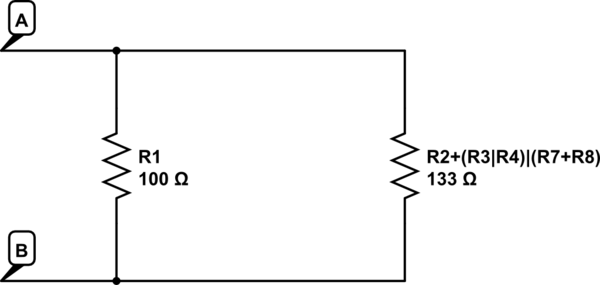My question is very direct. I understand the definitions and formulas involved in the association of resistors in both series and parallel, but when solving the circuit below, I don't quite understand whether or not to consider resistors R5 and R6, and how to do it, when trying to find the equivalent resistance between terminals A and B.
-
1\$\begingroup\$ One way of defining parallel resistors is ones that connect between precisely the same two nodes. If you try to identify the nodes that R5 and R6 connect to, are they the same? \$\endgroup\$– nanofaradCommented Jul 6, 2022 at 2:29
-
\$\begingroup\$ In fact, it seems to me that the voltage between the terminals of resistors R5 and R6 are zero. Is this correct? \$\endgroup\$– benjamin_eeCommented Jul 6, 2022 at 2:30
-
1\$\begingroup\$ If we assume that crossing wires connect (since usually they are drawn with dots), then both sides of R5 and R6 seem to be connected to the same node, namely B, so your assertion is correct. Tracing with a colored pen along every wire that makes up that node may help show this visually. Does that help you simplify the circuit further? \$\endgroup\$– nanofaradCommented Jul 6, 2022 at 2:32
-
\$\begingroup\$ Yes! And finally, R5 and R6 being connected, both terminals, at the same node, they do not influence the equivalent resistance at terminals A and B, right? So my solution depends on R1, R2, R3, R4, R7 and R8, right? \$\endgroup\$– benjamin_eeCommented Jul 6, 2022 at 2:53
-
\$\begingroup\$ Yes, that is correct. \$\endgroup\$– nanofaradCommented Jul 6, 2022 at 2:57
3 Answers
Re-arrange the circuit and it'll be easier to solve:
The idea is simple:
1. Node name doesn't change along a wire. Node B is a good example:
- For B, there's only a wire downwards, so the left-end of both R5 and R6 is B.
- For B, there's only wire to the right until R8's bottom end, so all these nodes along this way are B. This makes right-ends of both R5 and R6 B.
2. When you see a resistor along a wire then change the node name.
3. If a resistor has the same node names at its both ends then simply delete that resistor and replace it with wire with the respective node name. Because it's shorted. R5 and R6 is a good example since they both have B on their both ends.
Now let's re-arrange the circuit using the node names:

simulate this circuit – Schematic created using CircuitLab
It's way much easier to read, innit?
I'm leaving finding the equivalent resistance between A and B to someone else (ideally, you).
Don't be confused or mislead by the diagonal "wires". Resistors R5 and R6 are tied together at each end, so they are parallel by definition. In my experience it is almost always easier to do pairwise simplifications first, and then reduce more when it is 100% clear.
So you can forget R5 and R6 because they are parallel to a short. Also: R3 and R4 are parallel.
This leads to the following schematic

simulate this circuit – Schematic created using CircuitLab
Don't look at the values, they are just the default values in the schematic editor.
We can now continue to simplify. R7 and R8 are in Series so can just be added together. R3 and R4 are parallel, so we also combine them...

Now we see that R3|R4 and R7+R8 are parallel, so let's simplify again.

Now we can simplyfiy again because R2 and (R3|R4)|(R7+R8) are in series.

And now we have R1 and R2+((R3|R4)|(R7+R8)) parallel...
$$\frac{1}{\frac{1}{R1}+\frac{1}{R2+\frac{1}{\frac{1}{\frac{1}{R3}+\frac{1}{R4}}+\frac{1}{R7+R8}}}}$$
-
\$\begingroup\$ Please don't provide complete solutions to homework questions. \$\endgroup\$ Commented Jul 6, 2022 at 10:44


